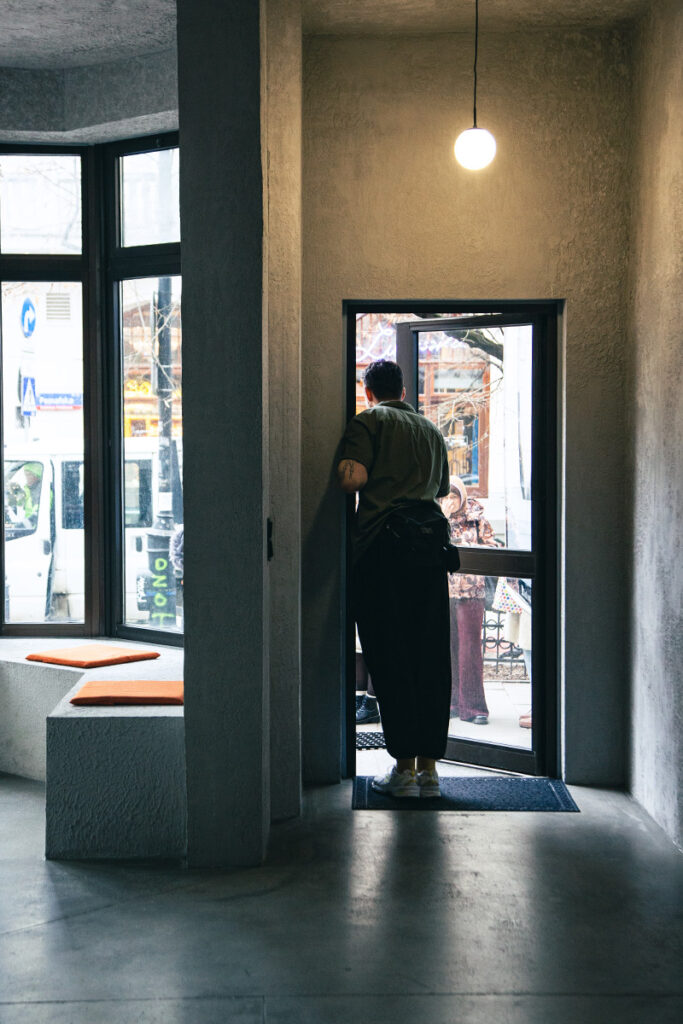

Originally beginning their journey with a stand in Poznań’s KontenerART complex, the popularity of Marcin Cieśluk’s and Shota Nakayama’s foamed-up matcha led to a café located in the city’s hip foodie district of Jeżyce. Now, destiny’s hand has led them to Warsaw, and to what many understand to be the city’s most enviable micro district – the heart of Hoża and Poznańska.

What’s In A Name?
Translated literally to mean ‘bean and leaf’, these are primary ingredients on a menu that is short and sweet. But don’t bother looking for the name on anything so gaudy as a flashy neon or a glitzy sign, instead just look for the snaking queue that wraps its way around the corner of the street.



Formally a beauty salon in one of Warsaw’s eye-widening 90s construction, this cafe has an open, cool grey interior of concrete and wood. In the main room, find some tatami platforms for sitting low to the ground, and then a bar with stools jutting off the main serving counter for those less eager to pop a squat. Taken together, these two annexes feel like they represent two different ideas.
On one hand, you have some space age modernism where sit as if in a Graviton surrounded by street-facing windows –
in front, two illuminated mesh-wire installations dangle from the ceiling as if they were clouds. Then, there’s the adjoining room. Entered through a curtain that looks like its for employees only, it surprises with its matcha-colored walls and Japanese adornments. More traditional, it vibes like a ceremonial tea room.



Matcha (i.e. powdered, ground green tea leaves) is not made from just ordinary green tea leaves. Leaves for matcha are grown in the shade, thereby increasing the chlorophyll content resulting in a darker green color and a more grassy taste. There are two kinds of matcha available in Japan and they are most distinguishable by their price. The more expensive is the purer, and that’s the one usually reserved for ceremonial tea drinking moments.
Less expensive is the version used in drinks or in confectionary but with most export matcha being organic, that naturally translates into the final price. So, a hat tip is due to Shota. Sourcing traditional non-organic matcha from Japan (the Japanese choice due to its less bitter taste), find him serving match latte with a choice of four kinds of milk (including low-sugar pea milk), and two authentic Japanese superfoods: a drizzling of melted black sugar from Okinawa called kuromitsu, and sprinkled shavings of roasted soybean (kinoko) that give the mouth a subtle peanut flavor.
With chemical compounds that relieve the nerves and stress levels but never sap the strength, this is matcha the way it’s meant to be. Of course, if that sounds too much, then a ceremonial matcha is available for the same price.


The menu is kept sweet to pair well with the matcha. Of the highlights, there’s a variety of daifuku mochi which are filled with seasonal delicacies and customer’s favorite fillings. There’s also dorayaki which are two small pancake-like patties stuffed with a filling of sweet azuki bean paste. And lastly, and most instagrammable of all, dango: rice balls made from rice flour before being topped with your choice of roasted salt or a traditional sweet soy-based sauce called mitarashi.

Keep an eye out on their FB and, in particular, their celebrations of Japanese holidays. Open only from Wednesday through till Sunday (from 2 p.m. to 7 p.m.), sold-out desserts and waiting around are the norm if you get there late.
Happa To Mame
Hoża 43/49, happatomame.pl
Words and photographs by Kevin Demaria
